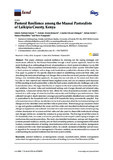| dc.description.abstract | This paper addresses pastoral resilience by drawing out the coping strategies and mechanisms utilized by the Maasai Pastoralists through a food system approach, based on the study findings of an anthropological study of pastoralism as a food system in Laikipia County, Rift Valley, Kenya. The co-existence and interactions of pastoralism as a food system with other types of food systems in Laikipia, such as large-scale horticulture, justified the selection of the study site.
This paper is guided by the specific objectives aimed at establishing actors and their roles, and describing the institutional settings and changes that sustain the continued practice of pastoralism. Using a new institutionalism approach, the paper focuses not only on the actors and their roles but also on how internal and external forces regulate access and use of common pool resources (CPRs) resulting in food sustainability within the food system amidst climatic challenges and cyclic humanitarian crises. We argue that this has an impact on the food system that continually defines and redefines the actors’ roles and institutional settings and changes (formal and informal rules, regulations, values and norms) that in turn affirm the value of pastoral economies and benefits accrued to a wide range of actors beyond the community and leading to pastoral resilience. Data collected through in-depth interviews amongst pastoral households identified actors and their roles
in pastoralism in the household with a total of 50 households being conveniently sampled. Key informant interviews with key stakeholders in the food system described the institutional settings and changes and also identified actors and their roles in pastoralism.
Three focus group discussions based on age and gender, established the actors and their roles and described institutional settings and changes to supplement data collected from interviews and unstructured observations aimed at giving a better description of the actors and their roles and also point to observable institutional settings and changes within and outside the community group ranches. The findings reveal that actors in the household, state, non-state, and service providers have developed varied coping strategies and mechanisms that sustain pastoralism.
The study also identified institutional settings and changes that promote pastoral resilience, notably, private land ownership patterns, co-management of livestock markets, commercialization of herding, decentralization of livestock services, holistic management of pasture and the water-shed management plans. As a result, increased scholarship and advocacy in regards to the concept of co-management of livestock markets, are recommended as a means of understanding the pastoral resilience that the food system exhibits. | en_US |



